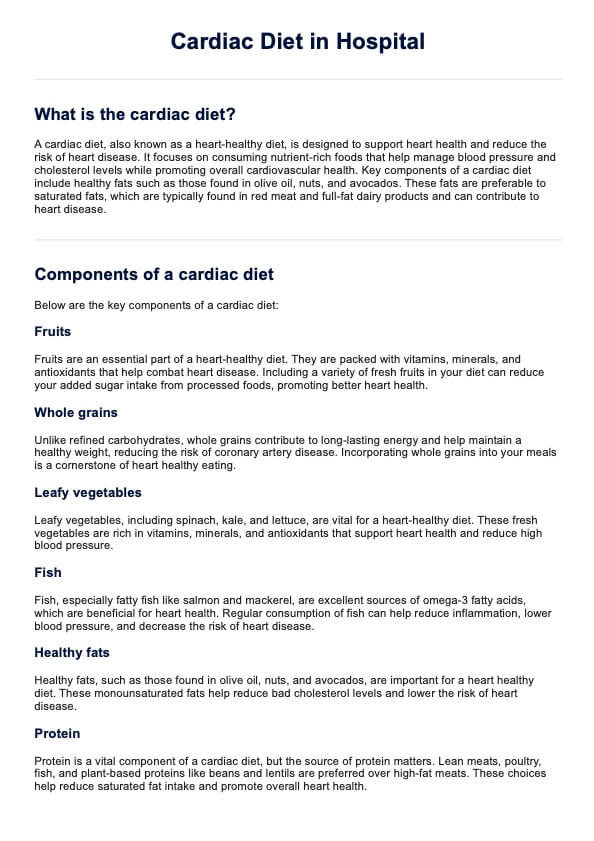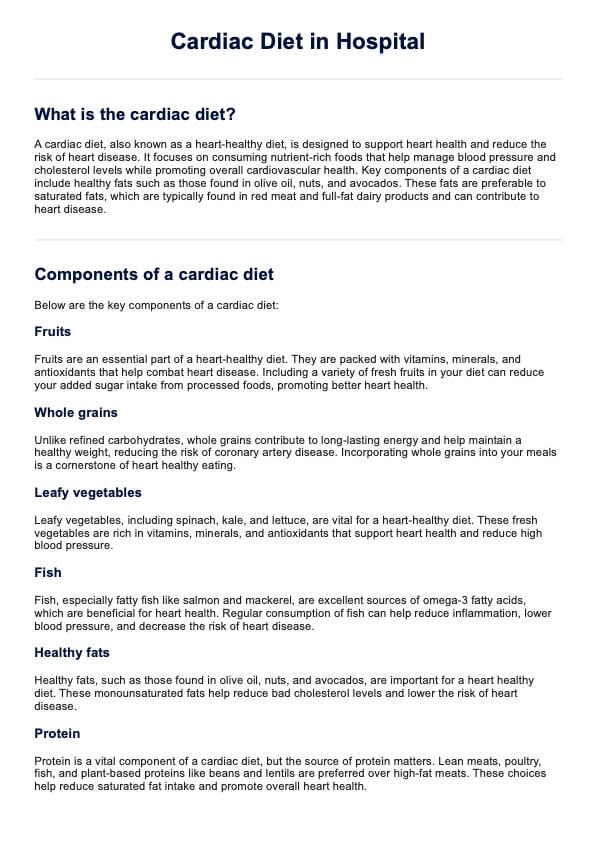Cardiac Diet in Hospital
Learn about the Cardiac Diet in Hospital with Carepatron's free PDF download that includes a handout and example meal plan. Understand the importance of nutrition for heart health.


What is a cardiac diet?
A cardiac diet, also known as a heart healthy diet, is designed to support heart health and reduce the risk of heart disease. This diet focuses on consuming nutrient-rich foods that help manage blood pressure and cholesterol levels while promoting overall cardiovascular health. Key components of a cardiac diet include healthy fats such as those found in olive oil, nuts, and avocados. These fats are preferable to saturated fats, which are typically found in red meat and full-fat dairy products and can contribute to heart disease.
The cardiac diet encourages the consumption of whole grains, such as whole grain bread and brown rice, over refined carbohydrates like white bread and sugary snacks. These whole grains are rich in fiber and essential nutrients that help maintain a healthy heart. Additionally, the diet emphasizes the inclusion of low fat dairy products, which provide necessary calcium and protein without the added saturated fat.
Fruits and vegetables, including fresh and frozen vegetables, are vital components of a heart healthy diet. These foods are packed with vitamins, minerals, and antioxidants that support heart health. Processed foods, which often contain high levels of salt, sugar, and unhealthy fats, should be limited to reduce the risk of heart disease.
Cardiac Diet in Hospital Template
Cardiac Diet in Hospital Example
What are the components of a cardiac diet?
A cardiac diet is a heart healthy diet aimed at reducing the risk of cardiovascular disease and improving overall cardiovascular health. This diet focuses on specific food groups and nutrient-rich choices that support heart healthy eating habits and help manage conditions like high blood pressure. Below are the key components of a cardiac diet.
Fruits
Fruits are the best heart healthy foods. They are packed with vitamins, minerals, and antioxidants that help combat heart disease. Including a variety of fresh fruits in your diet can reduce added sugar intake from processed foods, promoting better heart health. Consuming a colorful array of fruits supports overall well-being and aligns with the American Heart Association diet recommendations.
Whole grains
Whole grains, such as whole grain bread, brown rice, and oats, are crucial for a healthy diet. They provide fiber, essential nutrients, and help regulate blood sugar levels. Unlike refined carbohydrates, whole grains contribute to long-lasting energy and help maintain a healthy weight, reducing the risk of coronary artery disease. Incorporating whole grains into your meals is a cornerstone of heart healthy eating.
Leafy vegetables
Leafy vegetables, including spinach, kale, and lettuce, are vital for a heart healthy diet. These fresh vegetables are rich in vitamins, minerals, and antioxidants that support heart health and reduce high blood pressure. Including a variety of leafy greens in your meals can significantly improve your nutrient intake and promote a heart healthy lifestyle.
Fish
Fish, especially fatty fish like salmon and mackerel, are excellent sources of omega-3 fatty acids, which are beneficial for heart health. Regular consumption of fish can help reduce inflammation, lower blood pressure, and decrease the risk of heart disease. Replacing red meat with fish in your diet is a heart healthy choice recommended by many health experts.
Healthy fats
Healthy fats, such as those found in olive oil, nuts, and avocados, are important for a heart healthy diet. These monounsaturated fats help reduce bad cholesterol levels and lower the risk of heart disease. Limiting saturated fat intake from processed foods and choosing healthy fats instead supports better heart health and aligns with heart healthy eating practices.
Protein
Protein is a vital component of a cardiac diet, but the source of protein matters. Lean meats, poultry, fish, and plant-based proteins like beans and lentils are preferred over high-fat meats. These choices help reduce saturated fat intake and promote overall heart health.
Implementing a Cardiac Diet in Hospital
Implementing a cardiac diet in a hospital setting is essential for promoting heart health among patients and supporting their recovery. This diet emphasizes whole, nutrient-dense foods, such as fruits and vegetables, while minimizing processed meats and unhealthy fats. Adhering to dietary guidelines like the DASH diet and the Mediterranean diet can help in providing heart healthy meals that meet patients' nutritional needs.
Challenges
One of the primary challenges in implementing a cardiac diet in hospitals is ensuring consistent availability of fresh fruits and vegetables, which are crucial for heart health. Hospitals often rely on processed foods due to convenience and cost, which can hinder the adoption of a low sodium and low fat diet. Additionally, patients may have pre-existing dietary preferences or restrictions that make it difficult to adhere strictly to a cardiac diet.
Potential solutions
To overcome these challenges, hospitals can source locally grown fruits and vegetables to ensure a steady supply of fresh produce. Emphasizing the use of plant foods and incorporating more plant-based meals can align hospital menus with heart healthy dietary guidelines. Implementing training programs for hospital kitchen staff on the benefits of low sodium and low fat meal preparation can also help. Using alternatives to processed meats, such as lean proteins and low fat yogurt, can enhance the nutritional quality of meals. Following dietary guidelines from established heart healthy diets like the DASH diet and the Mediterranean diet can provide a structured framework for meal planning.
How to use our Cardiac diet in Hospital template?
Our Cardiac Diet in Hospital template by Carepatron is designed to streamline the implementation of a heart healthy diet for patients. This user-friendly template provides healthcare practitioners with the necessary tools to educate and guide patients towards better heart health through structured dietary plans.
Access and download the template
To begin, access the Carepatron platform and download the Cardiac Diet in Hospital template. You can find this in our Resource Library.
Review the handout and sample meal plan
Once downloaded, review the handout and sample meal plan included in the template. Familiarize yourself with the recommended foods, such as fruits and vegetables, and the exclusion of processed meats and trans fats.
Introduce the handout to the patient
Explain the importance of adhering to a heart healthy diet and how the template will help them make better food choices. Highlight the key components, such as the inclusion of plant foods and whole grains, and the avoidance of partially hydrogenated oils and high sodium foods.
Educate the patient with the meal plan
Educate the patient on how to follow the meal plan provided in the template. Discuss the benefits of each recommended food group and offer practical tips for incorporating these into their daily meals.
How can healthcare practitioners benefit from this template?
Healthcare practitioners can greatly benefit from the Cardiac Diet in Hospital template by Carepatron. This comprehensive tool simplifies the process of implementing a heart healthy diet for patients, ensuring that dietary recommendations align with established guidelines such as the DASH diet and the Mediterranean diet.
The template provides structured meal plans and handouts, reducing the time and effort needed to create individualized dietary plans. It also helps practitioners educate patients effectively about the importance of consuming fruits and vegetables, whole grains, and low fat options while avoiding processed meats and trans fats.
The ease of access and clear guidelines within the template enable practitioners to deliver consistent, high-quality nutritional advice, ultimately contributing to improved cardiovascular health and overall well-being for their patients.
Commonly asked questions
A cardiac diet in the hospital is a specialized eating plan aimed at promoting heart health and managing conditions like high blood pressure and cholesterol levels.
Cardiac patients are typically advised to follow a diet low in saturated fats, sodium, and cholesterol, while emphasizing fruits, vegetables, whole grains, and lean proteins.
Cardiac patients should consume foods rich in omega-3 fatty acids (found in fish like salmon), fiber (from fruits and vegetables), and healthy fats (such as those in nuts and olive oil) to support heart health.
Patients are placed on a cardiac diet to reduce the risk of heart disease, manage existing heart conditions, and improve overall cardiovascular health through balanced nutrition and healthy eating habits.







































































































